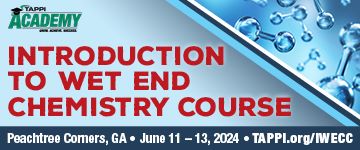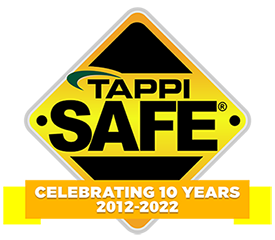 Search
Search
Use the search bar or filters below to find any TAPPI product or publication.
Filters
Publications
Level of Knowledge
Collections
Journal articles

Magazine articles

Factors affecting deposit formation in foul condensate stripping systems, TAPPI Journal June 2024
ABSTRACT: In kraft pulp mills, foul condensates are often steam-stripped to produce clean condensate for use as process water. The formation of organic deposits in the stripped condensate is a common problem. A systematic study was conducted to examine the deposit composition and the most likely operating parameters responsible for stripped condensate contamination experienced at a kraft mill in Brazil. Daily averaged data of 170 operating parameters over a 15-month period were analyzed by means of multivariate discriminant analysis and random forest classification analysis. The results showed that the deposit formation is related to high temperature, pressure, and dry solids operations in various evaporator effects. These conditions, combined with the poor demisting efficiency in these effects, may have increased black liquor carryover mist in the vapor. Deposit formation also appeared to be related to increased throughput of the foul condensate stripping system and increased pressure in the stripper. Results of Fourier transform infrared spectroscopy (FTIR) and pyrolysis-gas chromatography mass spectrometry (Py-GCMS) analyses show that the deposit consists of mostly organic matter that likely originated from wood extractives and lignin.
Journal articles

Magazine articles

Online monitoring of the size distribution of lime nodules in a full-scale operated lime kiln using an in-situ laser triangulation camera, TAPPI Journal June 2024
ABSTRACT: To maximize efficiency of the recausticizing process in a pulp mill, producing a reburned lime with high and consistent reactivity is process critical. Prior investigations have demonstrated a correlation between the reactivity of lime and its nodule size, as well as the dusting behavior of the kiln. Therefore, monitoring the nodule size produced in the lime kiln could be a promising indirect method to measure the performance of the lime kiln. The objective of this investigation was to evaluate the utility of a laser triangulation camera for online monitoring of nodule size distribution for the lime kiln. A series of full-scale trials were performed in a lime kiln of a kraft pulp mill in which a camera was installed at the exit conveyor to analyze the lime discharging from the kiln. The nodule size distribution was analyzed for correlation with the lime temperature, flue gas temperature, and rotational speed of the kiln. The monitoring demonstrated temporal stability, and the results showed that the lime temperature had the most significant effect on the nodule size. The rotational speed of the lime kiln and the flue gas temperature showed limited effect on nodule size, but they had significant impact on the specific energy demand. The overall conclusion of the study is that the camera methodology effectively correlates lime temperature with nodule size distribution, and it advocates for the methods of implementation in automating lime temperature control, facilitating the production of consistently reactive lime at a lower specific energy consumption.
Journal articles

Magazine articles

Editorial: TAPPI Journal Best Research Paper for 2023 focuses on black liquor concentration using graphene oxide membranes, TAPPI Journal February 2024
ABSTRACT: TAPPI and the TAPPI Journal (TJ) Editorial Board would like congratulate the authors of the 2023 TAPPI Journal Best Research Paper Award and Honghi Tran Prize: Sam Rae, Ella V. Richards, Max Kleiman-Lynch, Brent D. Keller, and Brandon I. Macdonald. Their paper, “Pilot scale black liquor concentration using pressure driven membrane separation,” appeared on p. 223 of the April 2023 issue. This kraft recovery cycle research was recognized by the TAPPI Journal Editorial Board for its innovation, creativity, scientific merit, and clear expression of ideas.
Journal articles

Magazine articles

On the diagnosis of a fouling condition in a kraft recovery boiler: combining process knowledge and data-based insights, TAPPI Journal March 2023
ABSTRACT: Fouling is still a major challenge for the operation of kraft recovery boilers. This problem is caused by accumulation of ash deposits on the surfaces of heat exchangers in the upper part of the boiler over time. The first consequence is the reduction of steam production due to loss of heat transfer and, finally, the shutdown of the boiler due to clogging. The present work investigated the operational condition of a modern kraft boiler under a critical fouling condition. This boiler had even faced a manual cleaning due to a clogging event. This analysis combined process knowledge, plant team experience, and a data-driven approach, given the complexity of the process. In this sense, historical data covering this critical period of operation were collected. After a cleaning procedure, they were used to obtain a predictive neural network model for the flue gas pressure drop in the boiler bank, which is an indirect measure of ash deposit accumulation. Once validated, it was used for sensitivity analysis, with the aim of quantifying the effects of the model inputs. Five variables out of eighteen accounted for nearly 60% of the total effect on pressure drop. Namely, primary air temperature (21.6% of the total effect) and flow rate (11.1%), black liquor flow rate (9.9%) and temperature (8.4%), and white liquor sulfidity (8.6%). The analysis of these results mainly suggested an excess of carryover, which composes the ash deposits. Recommended actions to mitigate the fouling condition involved adjustments to the primary air system before the more drastic solution of reducing the boiler load.
Journal articles

Magazine articles

Low-temperature precausticizing — a hopeful approach for green liquor desilication, TAPPI JOURNAL February 2017
Low-temperature precausticizing — a hopeful approach for green liquor desilication, TAPPI JOURNAL February 2017
Journal articles

Magazine articles

Kinetics of sulfur dioxide-alcohol-water (SAW) pulping of su
Kinetics of sulfur dioxide-alcohol-water (SAW) pulping of sugarcane straw (SCS), TAPPI JOURNAL June 2017
Journal articles

Magazine articles

Pulping and bleaching of Malaysian oil palm empty fruit bunc
Pulping and bleaching of Malaysian oil palm empty fruit bunches, TAPPI JOURNAL June 2017
Journal articles

Magazine articles

Preparing prehydrolyzed kraft dissolving pulp via phosphotungstic acid prehydrolysis from grape branches, TAPPI Journal January 2022
ABSTRACT: Dissolving pulp was successful prepared via phosphotungstic acid (PTA) prehydrolysis kraft (PHK) cooking followed by an elementary chlorine-free (ECF) bleaching process from grape branches. The effects of prehydrolysis temperature, reaction time, and PTA concentration that potentially affect the quality of dissolving pulp product on chemical components of pulp were studied via an orthogonal experiment. The structure of lignin was activated during the PTA prehydrolysis phase, and lignin was easily removed during the following cooking process. Thus, relatively mild conditions (140°C, 100 min) can be used in the cooking process. During the prehydrolysis phase, temperature exhibited the most significant influence on the cellulose purity of the obtained pulp fiber, followed by reaction time and PTA concentration. The optimized prehydrolysis conditions were as follows: prehydrolysis temperature, 145°C; reaction time, 75 min; and PTA concentration, 1 wt%. Whether the excessively high prehydrolysis temperature or prolonging the reaction time did not favor the retention of long chain cellulose, the delignification selectivity for the cooking process could not be further improved by excessive PTA loading. Under these prehydrolysis conditions, 94.1% and 29.0% for a-cellulose content and total yield could be achieved after the given cooking and bleaching conditions, respectively. Moreover, the chemical structure and crystal form of cellulose were scarcely changed after PTA prehydrolysis, which could be confirmed by results from Fourier transform infrared (FTIR) spectroscopy and X-ray diffraction (XRD). PTA prehydrolysis could be considered as an alternative method for preparing PHK dissolving pulp under relatively mild cooking conditions.
Journal articles

Magazine articles

Continuous tannin extraction by use of screw reactor, TAPPI Journal February 2021
ABSTRACT: A pilot-size screw reactor (extraction unit) was used for tannin extraction of spruce. Yield of the same magnitude or better was obtained when comparing a screw reactor with batch reactors. A longer presoaking time in water seemed to be better than a short one for obtaining higher yield. A higher yield is obtained with lower dry-water ratio, which suggests that the internal diffusion in bark does not determine mass transfer as much as is the case without presoaking of bark. The higher dry-water ratio decreased the yield. The prior soaking of the bark also minimized the mechanical reactor feeding problems (clogging). The benefits of a screw reactor likely are that run time changes for different process conditions are flexible; it simplifies design and construction of an industrial unit for tannin production; and it saves space because of the need for fewer and smaller intermediate storage tanks.
Journal articles

Magazine articles

Case study: Paper mill power plant optimization—balancing steam venting with mill demand, TAPPI Journal June 2020
ABSTRACT: Most Power departments are tasked with generating steam to support mill wide operations, generate electricity, and reduce operating costs. To accomplish these tasks, power boilers generate high pressure steam that is reduced to intermediate and low pressures for process utilization in the mill by means of steam turbine generator extraction or pressure reducing valves. The most economical method to reduce steam pressure is the use of steam turbine generators, as electricity is generated from the steam when it is reduced in pressure. Electricity that is produced by these generators provides a substantial financial benefit and helps offset overall operational costs. To achieve tangible financial gains, the mill must evaluate the overall cost of steam production and the price of electricity.The current work provides a case study of power plant optimization that evaluated electricity production and steam production costs balanced with mill steam demand. Process and cost optimization led to a significant reduc-tion in low pressure steam venting, resulting in reduced fuel consumption and reduced operating cost.






